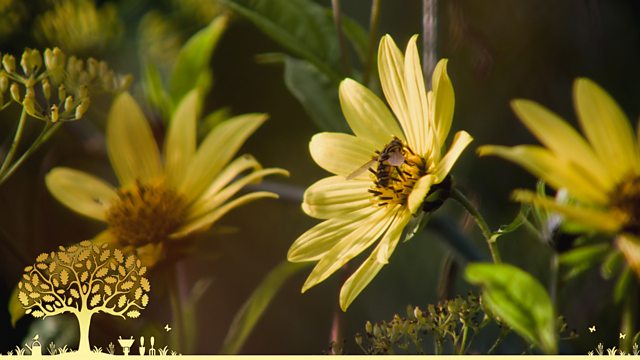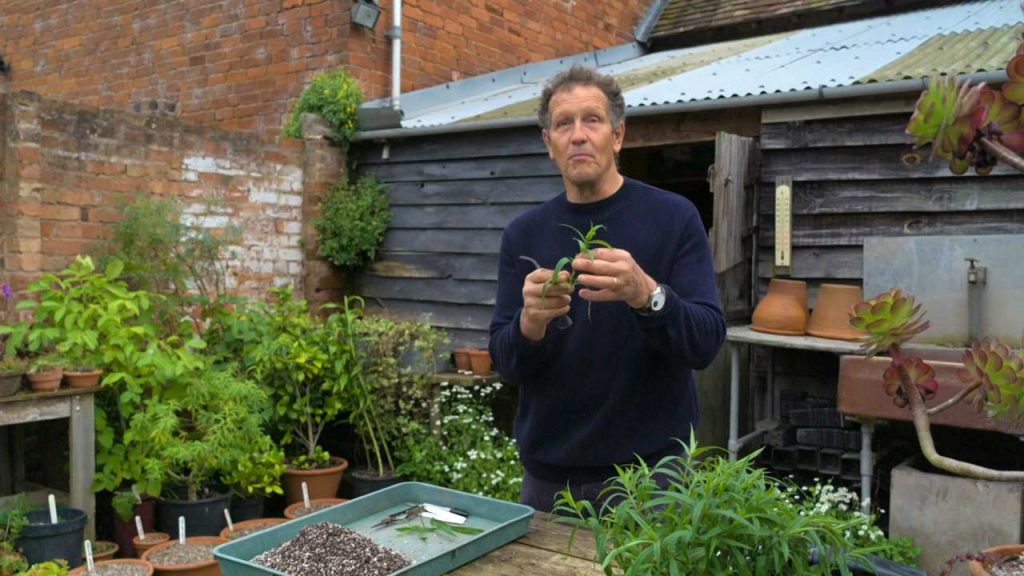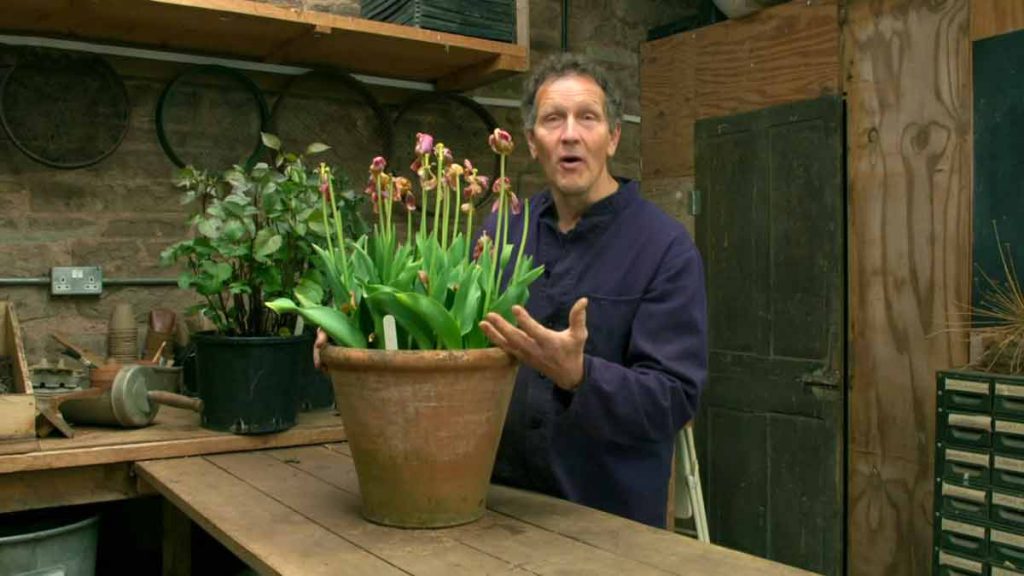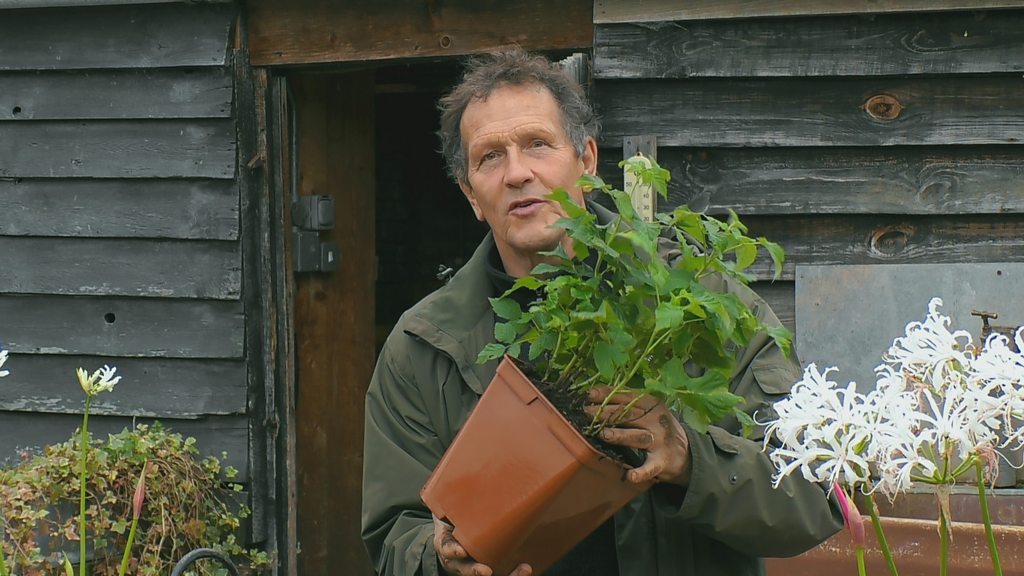Gardeners’ World 2021 episode 27: With autumn fast approaching, Monty is preparing the borders for the change of seasons and looking ahead to spring. Adam Frost and Advolly Richmond visit a glorious historic garden in North Yorkshire – Scampston Hall. Advolly will be delving into its fascinating history whilst Adam immerses himself in the design. He reveals how it has changed over the years and meets the head gardener, who is the current custodian of the garden.
We also visit an allotment in Warwickshire without a vegetable in sight. And we get lots of ideas and suggestions from our viewers’ own gardens.
Gardeners’ World 2021 episode 27
Tender perennial cuttings
Tender perennials such as verbena, bidens, gazanias and argyranthemums are best propagated each year from cuttings. In this way, you can keep the garden supplied with bushy, vigorous plants full of flowering potential. These propagation methods are suitable for tender perennials such as bidens, gazania, heliotrope, marguerites (Argyranthemum) and verbena.
All root quickly and easily, as do other frost tender plants including fuchsias, pelargoniums, penstemons and salvias. Although you can lift or mulch such plants in autumn, cutting them back and keeping them under glass over winter, they can become woody and are best replaced with young plants raised from cuttings. Foliage plants you may wish to bulk up include coleus (Solenostemon), plectranthus and Senecio maritima.
Most tender perennials propagate easily from cuttings. There are two methods that are particularly useful: semi-ripe cuttings and softwood cuttings. You can also find specific advice on salvias, penstemons and pelargoniums on our other web pages. Most cuttings taken in spring will be flowering in their first summer. Those taken in late summer will be overwintering under glass and be ready to harden off during May. One of the keys to overwintering rooted cuttings under glass is to keep them on the dry side in bright frost-free conditions of around 7°C (45°F).
It is easy to propagate a wide range of tender plants, but problems such as grey mould and damping off diseases can occur under glass where ventilation can often be inadequate. Pelargonium rust can be a problem in damp conditions. Fuchsias, usually trouble-free, but can suffer from fuchsia gall mite or fuchsia rust. Glasshouse whitefly can affect most plants under cover especially fuchsia, pelargonium, verbena and chrysanthemum.

Roof gardens and balconies
If you live in a building without its own garden, establishing a roof or balcony garden is the ideal way to create your own mini horticultural haven, ensuring you don’t miss out on growing a wide range of plants.
Depending on the level of exposure and altitude, a wide range of plants can be grown on a balcony or roof garden. The ideal method is to establish some shelter using screens or robust plants, which then creates a microclimate where other plants can survive. Plants that are tolerant of wind and sun tend to have leaf modifications that result in reduced surface evaporation. Examples are plants with needle-like leaves (pines, grasses or brooms) or very small leaves (cotoneaster or escallonia).
Leaves can be covered in lots of hairs, giving the foliage a grey appearance. Lavenders and santolinas are examples. Waxy cuticles protect plants like phormiums and cordylines from drying out. With regular watering, feeding and maintenance (pruning, re-potting etc.), your balcony or roof garden should be relatively trouble-free.
Potato and tomato blight – Gardeners’ World 2021 episode 27
Potato and tomato blight, also known as late blight to distinguish it from a different disease called early blight, attacks the foliage and fruit or tubers of tomatoes and potatoes, causing rotting. It is most common in wet weather.
Potato and tomato blight (late blight) is a disease caused by a fungus-like organism that spreads rapidly in the foliage and tubers or fruit of potatoes and tomatoes in wet weather, causing collapse and decay. It is a serious disease for potatoes and outdoor tomatoes, but not as common on tomatoes grown in greenhouses. Blight is specific to tomatoes, potatoes and some ornamental relatives of these two crops. Cases have been recorded on ornamental Solanum species (e.g. S. laciniatum), and also on Petunia.
Early blight is a different disease that is found widely in North America, and is commonly reported on the internet. This fungal disease of potatoes is caused by Alternaria solani and A. alternata. It is not a common problem in British gardens, and is often confused with the symptoms caused by the much more common magnesium deficiency.




